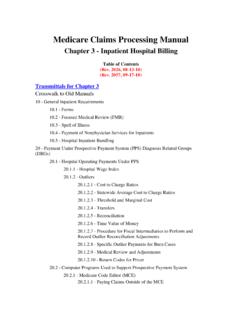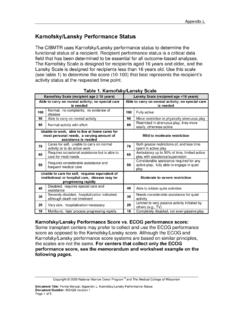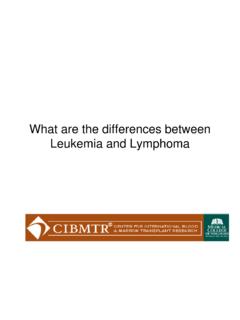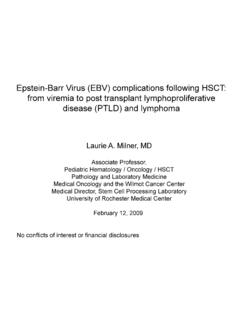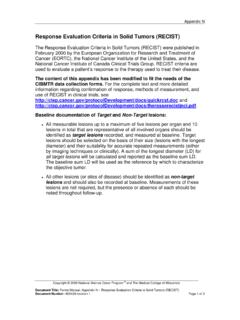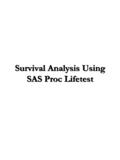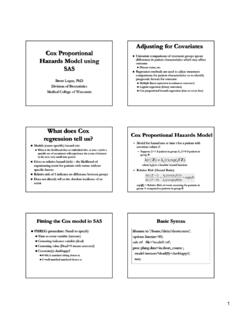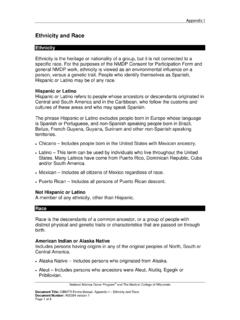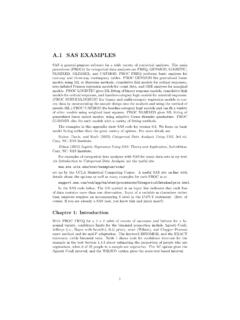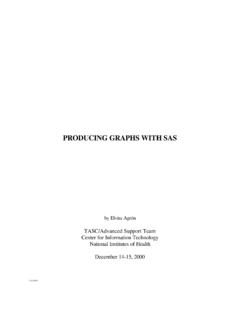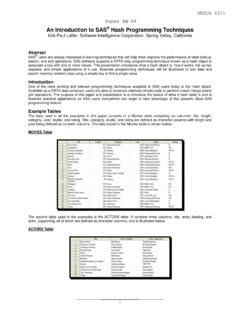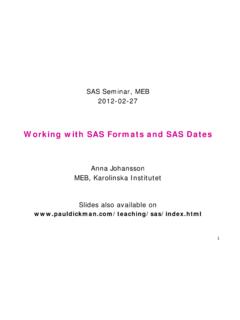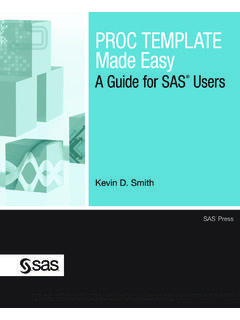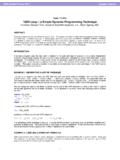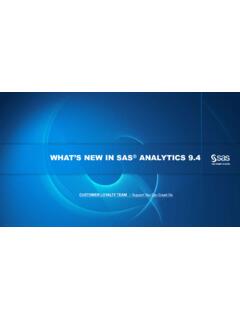Transcription of Survival Analysis Using SAS Proc Lifetest
1 Survival Analysis Using SAS Proc LifetestProc LifetestProc Lifetest Estimation of Survival Probabilities Estimation of Survival Probabilities Confidence Intervals and Bands, mean life median life mean life, median life Basic Plots Estimates of Hazards, log Survival , etc. Basic plots Tests of equality of groupsSample DataSample Data 866 AML or ALL patients 866 AML or ALL patients Main Effect is Conditioning Regimen71 (52 D d) R i1 (lbli) 71 (52 Dead) Regimp=1 (non-myeloablative) 171 (93 Dead ) Regimp=2 (reduced intensity 625 (338 Dead) Regimp=4 (myeloablative)Other Variablessexpatient's gender1 (male), 2 (female)disease10 (AML), 20 (MDS)agedecage by decade3 (30-39), 4 (40-49),5 (50-59)graftype1 (BM), 2 (PB)kps0 (<90), 1 (>90),99 (unknown)99 (unknown)danhlagrp2 type of donor0 (HLA-matched sibs), 1 (well-matched URD))
2 Yeartxyear of transplant2000, 2001, 2002, 2003, 2004 Outcome VariablesOutcome Variables Overall Survival Overall Survival intxsurv time from BMT to death or end of study dead1 dead 0 alive dead 1 dead 0 alive Relapse/TRM variables interval time from BMT to death or relapse trm 1 if dead in remission, 0 otherwise rel 1 if relapse prior to death, 0 otherwise lfs = trm+rel 1 if dead or relapsed, 0 otherwiseTwo Kinds of OutcomesTwo Kinds of Outcomes Survival Outcomes Survival Outcomes Observe T = min(Event time, censoring time) d=event indicator d=event indicator 1 event 0 censored observation 0 censored observation Censoring times are independent of event times example : Overall Survival , Disease Free Survivalp, Summary Statistics: Survival function, hazard rate mean/median time to eventrate, mean/median time to eventTwo Kinds of OutcomesTwo Kinds of Outcomes Competing Risk DataCo pet gs Data Two events Relapse, Death Occurrence of one of the events precludes occurrence of the other X=min(Time to event 1, Time to event 2)Ti (X titi ) T=min(X, time to censoring) Two event indicators R=1 if event of type 1, 0 OW D=1 if event of type 2, 0 OWyp, Summary Statistics.
3 Two cumulative incidence functions, crude hazard rate Two Kinds of OutcomesCompeting Risk DATAope g sExamplesEvent 1 Event 2 CensoringRelapseDeath in RemissionLost to follow-upGVHDD eath w/o GVHD(Relapse w/o GVHD)2ndtransplant, lost to follow-up/Engraftment (neurophil recovery)Death w/o recovery2ndtransplant prior to recoveryLost to follow-upySummary Statistics for Survival DataSummary Statistics for Survival Data X event time Survival function S(x)=P[X>x] Hazard Rate () lim [| ]hxPx X x x X x = + Note h(x) x probability a patient alive at start of day x dies on x0() lim [| ]xhxPx X x x X x = + of day x dies on xh(x)=-d ln(S(x))/dxSurvival DataParameters Cumulative Hazard Rate Cumulative Hazard RateH(x)= -ln[S(x)] = area under hazard rate curve up to x Mean Survival Time Mean Survival Time = area under Survival curve pth Quantile S(tp)=1-p(p)pSummary Survival Estimates Using Proc Lifetest ProcLifetestoptions;Proc Lifetestoptions; Time statementStrata statement Strata statement Test statement (use phreg)Bttt By statement Freq statementID ID statementExample Program 1 Data in Sas Data Set study data nmb; set study;if regimp=1;proc Lifetest data=nmb;time intxsurv*dead(0);Standard Number NumberINTXSURV Survival Failure Error Failed Left 0 0 0 71 1 1 70 2 69 3 68 4 67.
4 5 .. 5 66 6 65 .. 7 4079 0 2843 0 7157 0 0572 49 49 12 * .. 49 11 50 10 * .. 50 9 49 3421* 50 * .. 50 8 51 7 * .. 51 6 * .. 51 5 64 1447* 51 * .. 51 4 * .. 51 * .. 51 2 * .. 51 1 88 6184*51 .. 51 0 NOTE: The marked survivaltimes are censored EstimatesPoint 95% Confidence IntervalPercent Estimate Transform[Lower Upper)75 LOGLOG.]
5 50 LOGLOG LOGLOG Standard : The mean Survival time and its standard error were underestimated because to the largest event time was censored and estimation was restricted to the largest on study of the Number of Censored and Uncensored ValuesPercentTotal Failed Censored Censored71 51 20 Survival Column is Kaplan-Meier Product-Limit estimator (KME) Standard Error Greenwood s estimator of standard deviation of Kaplan-Meier estimator Mean is really the restricted is really the restricted mean. Here the area under the KME up to the largest event time (at ). () Some programs compute area up to largest on study time (Here ). () Limit can be changed to tmax by Using proc Lifetest timelim=tmaxpConfidence Bands and Intervals 95% Cfidi tl fS(t)95%t 95% Confidence interval for S(to) 95% sure true unknown Survival function at time to is in the random interval SL(to) to SU(to) 95% Confidence band for S(t) over range[ ] 95% sure true unknown Survival function is[ 1, 2] 95% sure true unknown Survival function is between the random curves SL(t ), SU(t ) for all 1<t< 2 Note Confidence bands much wider than confidence intervals Confidence intervals/bands found by finding a confidence interval for g(S) and converting back to SSCONFTYPE=keywordli(S) S (N d400) linear g(S)=S (Need n>400) asinsqrt g(S)= sin-1(S1/2) loglog g(S)
6 =log{-log(S)} log g(S)=log(S) logitg(S)= log[S/(1-S)] Recommend asinsqrt or loglog (Default). Good qgg( )for n>40 Confidence Band Choice of confband=ALL, ,HW, EP. EP bands are parallel to pointwise confidence intervalsproc Lifetest data=nmb timelist=20 40 60timelim=85 conftype=asinsqrt;ii*d d(0)time intxsurv*dead(0); SurvivalStand Number NumberTimelist INTXSURV Survival Failure Error Failed Left 43 28 49 12 51 6 proc Lifetest data=nmb timelist=20 40 60timelim=85 conftype=asinsqrt;ii*d d(0)time intxsurv*dead(0);Quartile EstimatesPoint 95% Confidence IntervalPercent Estimate Transform [Lower Upper)75 ASINSQRT.]
7 5012 6974 ASINSQRT6 809227 203950 ASINSQRT ASINSQRT Standard ErrorMean Standard : The mean Survival time and its standard error were underestimated because the largest observation was censored and the estimation was restricted to a time less than the largest Data Set with EstimatesOutput Data Set with Estimatesproc Lifetest data=nmb notable outsurv=survestproc Lifetest data nmb notable outsurv survest conftype=asinsqrt confband=ep bandmintime=10 bandmaxtime=70bandmintime 10 bandmaxtime 70 timelist =5 10 20 30 40 50 60 70 80 reduceout noprint stderr ;noprint stderr ;time intxsurv*dead(0);proc print data=survest;SDF_Obs TIMELIST INTXSURV _CENSOR_ Survival STDERR 154 967100 732390 0525401 5 0 2 10 0 3 20 0 30 0 4307.
8 85 40 0 6 50 0 7 60 0 8 70 0 9 80 0 Obs SDF_LCL SDF_UCL EP_LCL EP_UCL1 .. 2 .. 3 270360 494570 230080 541064 122770 350170 089050 403397 Using ODS graphicsGraphs Using ODS graphics Decide on output file type (pdf, html, rtf)Decide on output file type (pdf, html, rtf)ods pdf file= ; Enable ods graphics Enable ods graphicsods graphics on; Lifetest code with plot requests in plots=(list) Lifetest code with plot requests in plots (list) optionsProc Lifetest plots=( Survival ); Time t*d(1,2); run;Proc Lifetest plots ( Survival ); Time t d(1,2); run.
9 Turn ODS graphics off Ods graphics off Ods graphics offBasic GraphsBasic Graphsods pdf file= ex1 pdf ;ods pdf file ;ods graphics on;lifddl(i l ll l )proc Lifetest data=study plots=( Survival , lls, ls);time intxsurv*dead(0);strata regimp;run;run;ods graphics off;plots=(ls)vertical: cumulative hazard horizontal: timeCox model suggests curves should be multiples of each otherCox model suggests curves should be multiples of each otherH1(t)= 1H2(t)plots=(lls)vertical: log cumulative hazard horizontal:log timeCox model suggests curves should be parallelCox model suggests curves should be parallellog(H1(t)) =log( 1)+log(H2(t))ods pdf file= ;ods graphics on;proc Lifetest data=study plots=( Survival (atrisk=0to80by20nocensorfailure));plots ( Survival (atrisk 0 to 80 by 20 nocensor failure));time intxsurv*dead(0); strata regimp; run;ods graphics off;ods pdf file= ;ods graphics on;proc Lifetest data=study plots=( Survival (cl cb=ep strata=panel));plots ( Survival (cl cb ep strata panel));time intxsurv*dead(0); strata regimp; run;ods graphics off;ods pdf file= ;ods graphics on;proc Lifetest data=study plots=(hazard(bw=10));time intxsurv*dead(0); strata regimp; run;ods graphics off.
10 Summarizing Competing RisksSummarizing Competing Risks X time to smaller of two risks Event indicators R=1 if event of type 1, 0 ow D=1 if event of type 2 0 ow D=1 if event of type 2, 0 ow =1 if type 1 event, 2 if type 2 event 0 ow Crude Hazard Ratesh()d Chti t illit1t10() lim [, 1|]xhxPx X x xX x = += h1(x)dx Chance a patient will experience a type 1 event today given they have not experienced either event at the start of the daySummarizing Competing RisksSummarizing Competing Risks Cumulative Incidence FunctionCumulative Incidence Function1() [, 1]tuCt PX t = = NOTES:11200()exp[ [ () ()] ]uh uh vh v dv du= + NOTES: Proc Lifetest does not provide estimates of these quantities Proc Lifetest can be used for tests for competing risks Proc Lifetest can be used for tests for competing risks SAS macros available to compute cumulative incidenceCumulative incidence Download macro to your working directory Download macro to your working directory Assuming macro is in file cimacro in your home directory usedirectory use%include cimacro ;Use %incid(data group event1 event2 time out=outdsn);Use %incid(data,group,event1,event2,time,out outdsn); data name if data set where your data is group---variable with group indicators groupvariable with group indicato
